1998-1999 Olympiad Correspondence Problems
Set 4
- 19.
-
The following statics problems involving vectors was
given and two separate solutions provided. Determine whether
either of them is correct and explain the discrepancy between
the answers.
-
-
Problem. A force R of magnitude 200 N (Newtons)
is the resultant of two forces F and G for which
2 |F | = 3 |G | and the angle between
the resultant and G is twice the angle between the resultant
and F. Determine the magnitudes of F and G.
-
-
Both solutions use
the parallelogram representation of the vectors as
illustrated, where 3u = |F |, 2u = |G| and v = |R | = 200. From the Law of Sines, we
have that
whence cos
q = 3/4, cos2
q = 1/8 and
cos3
q = 4cos
3 q- 3cos
q = -9/16.
>From here, there are two ways to proceed:
-
-
(i) From the Law of Cosines, we find that
|
v2 = 4u2 + 9u2 - 12u2 cos(180° - 3q) = 13u2 + 12u2 cos3q = |
25u2
4
|
|
|
so that 200 =
5/
2u, u = 80,
|F | = 240
and
|G | = 160.
-
-
(ii) From the Law of Cosines, we find that
|
4u2 = 9u2 + v2 - 6uv cosq = 9u2 + 2002 - 900u |
|
so that
|
0 = 5(u2 - 180u + 8000) = 5(u - 80)(u - 100) . |
|
Hence, u = 80,
|F | = 240,
|G| = 160 or u = 100,
|F | = 300,
|G | = 200.
-
-
Why does method (i) lead to one solution while
method (ii) yields two? QED
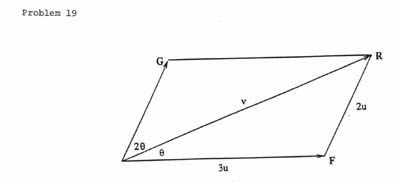
View solution
- 20.
-
Using a pair of compasses with a fixed radius
exceeding half the length of a line segment AB, it is possible
to determine a point C for which the triangle ABC is
equilateral. Here is how it is done.
-
-
With centres A and B construct circles using the
compasses and let P be one of the two points of intersection
of these circles. Draw the circle with centre P, and let
it intersect the circle of centre A in Q and the circle of
centre B in R. There are different possible configurations,
but we will select one so that QR is parallel to AB.
Now construct, using the compasses again, circles of centres
Q and R. These will intersect in P and a second point
C. Prove that triangle ABC is equilateral.
View solution
- 21.
-
In the following problem, we will begin by making some
empirical observations. Your task will be to formulate some
general results exemplified by them and provide proofs. You may
observe some other general results not really pointed to below;
if so, formulate and justify these.
-
-
The numbers 1, 2, 3, ¼ are placed in a triangular
array and certain observations concerning row sums are
made as indicated below:
The odd row sums of this array are 1, 35, 189, 559, ¼ and
their running totals are 1 = 12, 36 = 22 ·32 = (1+2+3)2, 225 = 32 ·52 = (1+2+3+4+5)2, 784 = 42 ·72 = (1+2+3+4+5+6+7)2, ¼,
You will notice that the square roots are the sum of odd sums of
consecutive integers. Even sums are not to be left out. The even
row sums in the array are 9, 91, 341, ¼ and their running
totals are 9 = 12 ·32 = (1+2)2, 100 = 22 ·52 = (1+2+3+4)2, 441 = 32 ·72 = (1+2+3+4+5+6)2, ¼.
We can continue in this vein. Writing the triangular array with
1, 4, 7, 10, ¼ numbers in the consecutive rows, we find the
running totals of the odd sums to be 1, 64 = 82 = 22 ·42,
441 = 212 = 32 ·72 and so on. With 1, 5, 9, 13, ¼
numbers in the consecutive rows, the running totals of the odd
sums are 1, 100 = 102 = 22 ·52, 729 = 272 = 32·72.
View solution
22.
- The diagonals of a concyclic quadrilateral ABCD
intersect in a point O. Establish the inequality
|
|
AB
CD
|
+ |
CD
AB
|
+ |
BC
AD
|
+ |
AD
BC
|
£ |
OA
OC
|
+ |
OC
OA
|
+ |
OB
OD
|
+ |
OD
OB
|
. |
|
View solution
23.
- Let A1, A2, ¼, Ar be subsets of
{ 1, 2, ¼, n } such that no Ai contains another.
Suppose that Ai has ai elements (1 £ i £ r). Prove
that
|
|
å
| |
æ
ç
è
|
n
ai
|
ö
÷
ø
|
-1
|
£ 1 . |
|
View solution
24.
- Without recourse to a calculator or a computer, give
an argument that 5123 + 6753 + 7203 is composite.
View solution
Problem 19.
- 19.
-
First solution. Method (i) leads to the equation
0 = (5u - 2v)(5u + 2v) while (ii) leads to
4u2 = 9u2 + v2 - 9uv/2 or 0 = (5u - 2v)(2u - v). Let us
examine closely the second answer that is provided by (ii).
In this case, the triangle formed by the two vectors and their
resultant is isosceles with sides of magnitudes 3u, 2u and
2u with the base angle equal to q and the apex angle
equal to 180° - 2q. In this configuration,
cosq is indeed 3/4, but the apex angle is not
2q as specified in the statement of the problem.
Indeed, method (i) made use of the angle between R
and G. However in method (ii) the result of the sine
law remained valid with 180° - 2q in place of
2q but the cosine law did not make use of the angle
between R and G. So it is not surprising that
the second method leads to a spurious possibility.
Problem 20.
- 20.
-
There are various configurations,
and we give the solution for one of these. The solutions for the
other are similar.
- 20.
-
First solution. See Figure 20.1.
We have that AP = AQ = QP = QC. Let
ÐQAC = ÐQCA = q, so that ÐAQC = 180°- 2q. Then ÐPQC = ÐAQC - 60° = 120° - 2q, so that ÐQCP = ÐQPC = 30° + q. Thus, ÐACP = 30°.
Since CP ^AB, ÐCAB = 60°. Similarly,
ÐCBA = 60° and so DABC is equilateral.
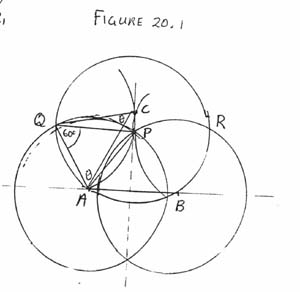
- 20.
-
Second solution.
See Figure 20.2.Consider the reflection in the
right bisector of AB. It interchanges circles with centres
A and B, and hence fixes their intersection points,
in particular P. This reflection also carries the circle
with centre P to itself. Hence the point C is fixed by the
reflection. It follows that P and C are on the right bisector
of AB.
-
-
Suppose that PC intersects AB in S. Let ÐSAP = q. Then ÐAPB = 180° - 2q. Also
|
ÐQPC = 180° - ÐAPQ - ÐAPS = 180° - 60° - (90° - q) = 30° + q |
|
whence
|
ÐPQC = 180° - 2(30° + q) = 120°- 2q |
|
and
|
ÐAQC = 60° + ÐPQC = 180° - 2q . |
|
Hence DAQC º DAPB (SAS) so that AC = AB and the
result follows.
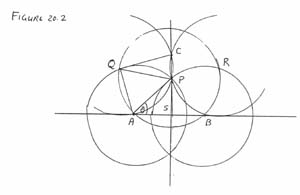
-
-
Third solution. See Figure 20.3.
A 60° clockwise rotation about A followed by a
60° clockwise rotation about B takes
A ® A ® D and Q ® P ®R, where D is the third vertex of an equilateral triangle
with side AB. Hence AQ ® DR so that |DR | = |AQ |, the radius of the circle.
-
-
Similarly, the composition of two counterclockwise rotations
with respective centres B and A takes B ® B ®D and R ® P ® Q, so that |DQ | = |BR |, the radius of the circle. Hence D is a point
of intersection of the circles with centres Q and R. When the
radius is not equal to |AB |, this will be distinct from
P, so that D = C, and the result follows.
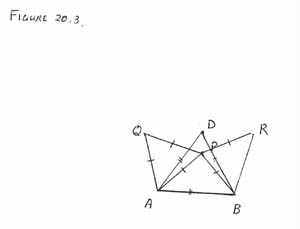
Problem 21.
- 21.
-
First solution. Consider the triangular array
in which the consecutive positive integers are written in rows
with only the number 1 in the top row and
with k ³ 0 more elements in each row than the previous one.
For r ³ 1, the rth row has (r-1)k + 1 elements
beginning with ((r-1) || 2)k + r and ending with
(r || 2)k + r. The sum of the numbers in the rth row is
|
| |
|
|
|
é
ê
ë
|
|
æ
ç
è
|
|
æ
ç
è
|
r-1
2
|
ö
÷
ø
|
+ |
æ
ç
è
|
r
2
|
ö
÷
ø
|
|
ö
÷
ø
|
k + 2r |
ù
ú
û
|
|
| |
|
= |
1
2
|
[(r-1)k + 1][(r-1)2k + 2r] |
| |
| = |
1
2
|
[ (r-1)3 k2 + (3r2 - 4r + 1)k + 2r] . |
|
| |
|
When r = 2s - 1, this sum is
|
4(s-1)3 k2 + (6s2 - 10s + 4)k + (2s - 1) |
|
and the sum of the first m odd-numbered rows is the sum of
these terms over 1 £ s £ m, namely
|
[m(m-1)k]2 + 2m2(m-1)k + m2 = [m((m-1)k + 1)]2 . |
|
-
-
When k = 0, the sum of the elements in the sth
odd-numbered row is 2s - 1 and the sum of the elments in the
first m odd-numbered rows is m2, the sum of the first m
odd integers.
-
-
When k = 1, the sum of the elements in the sth
odd-numbered row is
|
| |
|
|
+ (6s2 - 10s + 4) + (2s - 1) = 4s3 - 6s2 + 4s - 1 |
| |
|
= s4 - (s-1)4 = [s2 - (s-1)2][s2 + (s-1)2] |
| |
| = [(s-1) + s][(s-1)2 + s2] |
|
| |
|
and the sum of all the elements in the first m odd-numbered
rows is m4.
-
-
When k = 2, the sum of the elements in the first
m odd-numbered rows is
|
[m(2m - 1)]2 = [(1/2)(2m)(2m-1)]2 = [1 + 2 + ¼+ |
2m-1
|
]2 . |
|
-
-
When r = 2s, the sum of the elements in the rth row
is
|
|
1
2
|
[(2s - 1)3 k2 + (12s2 - 8s + 1)k + 4s] . |
|
For k = 0, this sum is 2s. When k = 1, the sum is
4s3 + s = s[1 + (2s)2] and the sum of all the elements
in the first m even-numbered rows is
|
| |
|
|
+ |
1
2
|
m(m+1) = |
æ
ç
è
|
m+1
2
|
ö
÷
ø
|
[m2 + (m+1)2] |
| |
| = [1 + 2 + ¼+ m][m2 + (m+1)2] . |
|
| |
|
For k = 2, the sum of the numbers in the sth even-numbered
row is
|
2(2s - 1)3 + (12s2 - 8s + 1) + 2s = 16s3 - 12s2 + 6s - 1 = (2s - 1)3 + (2s)3 |
|
and the sum of all the elements in the first m even-numbered
rows is
|
|
m
å
s = 1
|
[(2s - 1)3 + (2s)3] = |
2m
å
r = 1
|
r3 = [1 + 2 + ¼+ 2m]2 . |
|
Problem 22.
- 22.
-
First solution. Let the points and lengths be
as labelled in the diagram, and let q = ÐAOB,
a = ÐBAD, b = ÐABC. Then
ÐBCD = 180° - a and ÐCDA = 180° - b. Then, where [ ¼] denotes
area,
|
2[ABC] = ab sinb = (p + q)rsinq |
|
|
2[ACD] = cd sinb = (p + q)s sinq |
|
so that r/s = (ab)/(cd). Similarly p/q = (ad)/(bc).
Hence
|
|
p
q
|
+ |
r
s
|
= |
a
c
|
|
æ
ç
è
|
|
d
b
|
+ |
b
d
|
|
ö
÷
ø
|
³ 2 |
a
c
|
|
|
|
|
p
q
|
+ |
s
r
|
= |
d
b
|
|
æ
ç
è
|
|
a
c
|
+ |
c
a
|
|
ö
÷
ø
|
³ 2 |
d
b
|
|
|
|
|
q
p
|
+ |
r
s
|
= |
b
d
|
|
æ
ç
è
|
|
c
a
|
+ |
a
c
|
|
ö
÷
ø
|
³ 2 |
b
d
|
|
|
|
|
q
p
|
+ |
s
r
|
= |
c
a
|
|
æ
ç
è
|
|
b
d
|
+ |
d
b
|
|
ö
÷
ø
|
³ 2 |
c
a
|
|
|
and the result follows.
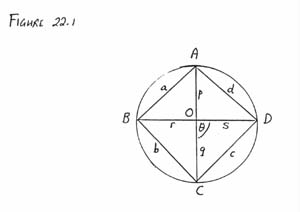
-
-
Second solution. From similar triangles,
we find that a/c = r/q = p/s, b/d = r/p = q/s, so that
pq = rs. Then
|
| |
|
|
+ |
q
p
|
+ |
r
s
|
+ |
s
r
|
|
ö
÷
ø
|
- |
æ
ç
è
|
|
a
c
|
+ |
c
a
|
+ |
b
d
|
+ |
d
b
|
|
ö
÷
ø
|
|
| |
|
= |
æ
ç
è
|
|
p
q
|
+ |
q
p
|
+ |
r
s
|
+ |
s
r
|
|
ö
÷
ø
|
- |
æ
ç
è
|
|
r
q
|
+ |
s
p
|
+ |
q
s
|
+ |
p
r
|
|
ö
÷
ø
|
|
| |
| = |
p2 + q2 - pr - qs
pq
|
+ |
r2 + s2 - qr - ps
rs
|
. |
|
| |
|
Since pq = rs, this is a fraction over a common
denominator with numerator
|
| |
|
|
r2 + s2 - pr - qs - rq - sp |
| |
| = |
1
2
|
[ (p - r)2 + (q - s)2 + (q - r)2 +(s - p)2] , |
|
| |
|
which is nonnegative. The result follows.
-
-
Third solution. Begin as in the second solution. Then
|
| |
|
| |
| |
| |
|
£ |
|
| ______________
Öp2 + q2 + r2 + s2
|
|
| ______________
Ör2 + s2 + q2 + p2
|
pq
|
|
| |
| |
| |
|
| |
|
from the Cauchy-Schwarz Inequality.
Problem 23.
- 23.
-
First solution. There are n! arrangements
of the first n natural numbers. Suppose that ai = k;
consider the arrangements { x1, x2, ¼, xn }
where Ai = { x1, x2, ¼, xk } (i.e.,
the first ai numbers constitute the set Ai). There
are k! possible ways of ordering the first k numbers
and (n-k)! ways of ordering the remaining numbers
so that there are ai! (n - ai)! arrangements of this
type. Let i ¹ j. No arrangement { x1, x2, ¼, xn } can at the same time have its
first ai elements coincide with Ai and its first
aj elements coincide with aj, since neither of
Ai and Aj is contained in the other. Hence
ai! (n - ai)! arrangements corresponding to Ai
are distinct from the aj! (n - aj)! arrangements
corresponding to Aj. It follows that
|
|
n
å
i = 1
|
ai! (n - ai)! £ n! |
|
and the result obtains.
Problem 24.
- 24.
-
First solution. Observe that
512 = 29, 675 = 33·52 and 720 = 24 ·32 ·5, so that
2 ·7202 = 3 ·512 ·675.
We now use the identity
|
x3 + y3 + z3 = x3 + y3 - z3 + 3xyz = (x + y - z)(x2 + y2 + z2 - xy + xz + yz) |
|
which is valid when 2z2 = 3xy to obtain that
|
5123 + 6753 + 7203 = (512 + 675 - 720)(5122 + 6752 + 7202 - 512·675+ 512 ·720 + 675 ·720) . |
|
Thus, 467 = 512 + 675 - 720 is a factor of the sum of cubes.
- 24.
-
Second solution. [P. LeVan]
|
| |
|
|
+ 6753 + 7203 = 5123 + 453 [153 + 163] |
| |
|
= 5123 + 453 [(16 - 1)3 + 163 ] |
| |
|
= 5123 - 453 + 453 ·16 [2 ·162 - 3 ·16 + 3] |
| |
|
= (512 - 45)(5122 + 512 ·45 + 452) + 453 ·16[512 - 3 ·15] |
| |
|
= 467[5122 + 512 ·45 + 452] + 453 ·16 [467] |
| |
| = 467 [5122 + 512 ·45 + 452 + 453 ·16] |
|
| |
|
so that 467 is a factor of the sum of the cubes.
- 24.
-
Third solution. [D. Pritchard] We have the
identity
|
(a9)3 + (b3 c2)3 + (a4 b2 c3)3 = a27 + b9 c6 + a12 b6 c3 |
|
|
= (a9 + b3 c2 - a4 b2 c)(a18 - a9 b3 c2 + b6 c4+ a13 b2 c + a4 b5 c3 + a8 b4 c2) + (2b - 3a)a12 b5 c3 . |
|
Now take (a, b, c) = (2, 3, 5) to yield the desired result, one
factor being 467.
- 24.
-
Fourth solution. [D. Arthur] Writing
512 = 1/2(x + y), 675 = 1/2(x + z) and
720 = 1/2(y + z) yields (x, y, z) = (467, 557, 883). Modulo 467, we find that
|
| |
|
|
º 8-1(2y3 + 2z3 + 3y2z + 3yz2) |
| |
| = 8-1(y + z)(2y2 + 2z2 + yz) . |
|
| |
|
[Note that 8-1 represents a number a for which
8a º 1 (mod 467).] Now y º 90 and
z º -51, so that
|
| |
|
|
º 2 ×902+ 2 ×512 - 90 ×51 |
| |
|
= 9 [4 ×450 + 2 ×289 - 510] |
| |
| º 9 [- 4 ×17 + 578 - 510] = 9 [-68 + 68] = 0 |
|
| |
|
and so the sum of the cubes is divisible by 467.
- 24.
-
Comment. In fact,
|
5123 + 6753 + 7203 = 229 ×467 ×7621 . |
|
© Société mathématique du Canada, 2025

